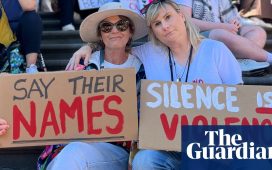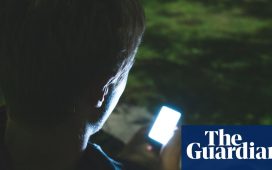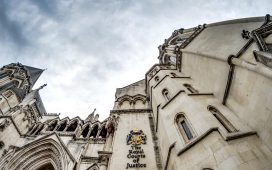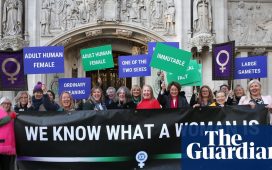October marks the 10th anniversary of the murder of Claire Throssell’s two sons, Jack and Paul, by their father. He had lured them to the attic with sweets and a new train set, then barricaded the house and started 14 fires. He’d locked all the doors, secured the patio doors with a heavy bike lock and used chairs and mattresses as extra barriers to slow down firefighters.
Jack and Paul, aged 12 and nine, hadn’t wanted to visit their father, Darren Sykes. He had previously hit both them and their mum. He’d made them eat until they were sick. He used to call them “mummy’s boys”. Paul had explained all this to a worker at Cafcass (Children and Family Court Advisory and Support Service) in a formal interview. Throssell had said in an evidence statement that, when angry, Sykes was capable of hurting or killing the boys, that he had told her he intended to take his own life and that he could understand fathers killing their children. Still, contact was awarded to him.
Ten years on – or, in her own words, “10 years into my life sentence” – Throssell cannot believe how little has been learned. “I’ve had sleepless nights knowing that the judge who made the contact order was still on the bench and the Cafcass worker who interviewed Paul has never been held accountable,” she says.
“I don’t live now, I exist,” she continues, “and the only reason I exist is to make a difference. There are days I wake up disappointed I’m alive, but then I remember that I made a vow to get my children’s voices heard. We need a true overhaul of the family courts – and if I can’t get that, why am I still here?”
Most cases that reach the family courts, like Throssell’s, involve allegations of domestic abuse. Occasionally they make the news – one recent example highlighted the child contact awarded to a serial rapist. Kristoffer Paul Arthur White was judged to have abused, raped and coercively controlled his ex-partner. He had also served a jail sentence for dragging a teenager into a garden, threatening to kill her and raping her twice. Despite this, he was granted unsupervised contact with his daughter.
A paper published in August by the Shera research group, examined 10 anonymous family court cases involving allegations of child sexual abuse carried out by the father – including cases where the father had admitted to it, or there was digital or video evidence, and one of child rape that had led to a prison sentence. In all of these cases, the father ultimately won some form of contact with their children, including overnight stays and 50/50 shared residency. One woman, whose ex was given five years on the sex offender register for downloading child sexual abuse images, mainly of girls, including babies and young children, was told by her Cafcass worker: “Well, it’s all right because you’ve got a son.”
From time to time, cases like these alarm the public. Usually, though, family courts operate with little outside scrutiny, and under heavy reporting restrictions in order to protect children from unwanted publicity. Domestic abuse organisations regularly cite the courts as the single most common grievance raised by survivors, who say they retraumatise families and place them back in danger. The Women’s Aid Child First campaign, which focused on 19 children killed in circumstances involving unsafe child contact, helped lead to the creation of an expert panel by the Ministry of Justice, which aimed to assess the harm to children caused by family court proceedings. Its final report, published in 2020, made 72 recommendations designed to change the culture from “pro-contact” to “safety and protection” above all else. “It was wonderful and confirmed everything we’d been saying,” says Sophie Francis-Cansfield, head of policy at Women’s Aid. “Four years later, very few of those recommendations have been implemented. Progress has been incredibly slow.”
Ironically, Throssell – like many victims of domestic abuse – had first turned to the family courts for protection. “I couldn’t fight on my own any more and I trusted the courts to see sense,” she says. Throssell, who is from Penistone, South Yorkshire, had been married to Sykes, a carpet salesman, for 16 years, and for much of that he had been violent and controlling. For a long time, she had wanted to leave him and her children had wanted to go too. “They used to say: ‘When are we leaving, Mum?’ ‘When will it just be the three of us?’ I was trying to stay until they were both old enough to choose not to see their dad,” says Throssell. There is no set age for this, though in practice it’s usually 16. The thought of them alone in his care was enough to keep her in the marriage. “He used to always say: ‘Don’t think you’re leaving because if you do, you can leave them two here.’”
In April 2014, though, Throssell did leave. She hadn’t planned it. Sykes had been standing at the top of the stairs, shouting at Jack, and as he was about to land a blow, Throssell intervened. The force of his fist threw her down the stairs. Jack and Paul ran to her side and Sykes stood at the top. “I just told the boys to run to the car,” says Throssell. “I got up and followed them and we drove to my mum’s.” They never returned.
That summer – the boys’ last – was the happiest they had ever had. “It was the only summer of their lives that they really enjoyed,” says Throssell. From May through to mid-August, they didn’t see their dad. “They could be normal children – they didn’t have any fear,” says Throssell. “We went to the beach at Lytham St Annes and Paul just threw himself into the water with his clothes on because he could and not be told off. There was no walking on eggshells, not knowing what mood someone was in. I’ve got a photograph of them at the top of Blackpool Tower and they haven’t got a care in the world. They said they were flying.”
Just after that trip, Sykes turned up at Throssell’s mother’s house while Throssell wasn’t there and took Jack on an unauthorised “contact visit”. “He dragged Jack by the collar and there was nothing my mum could do,” says Throssell. That’s when she turned to the family courts.
Her first experience in the courtroom shocked her. Most cases involve allegations of domestic abuse, and women who have fled their ex-partners. Here they were expected to face them again, in close proximity – to sit beside them in waiting rooms, listen while they spun a story. “There were no safety measures,” she says. “He was right there, glaring at me, then verbally attacking me. Then you go inside and it’s like a boardroom with him sitting four seats away, hurling insult after insult. At one point the judge had to tell him to be quiet. I thought this was clear evidence that he can’t control his emotions and wasn’t safe to be around.” Instead, Sykes was awarded five hours’ contact a week. Although the judge ordered a section 7 report by Cafcass (a detailed report into the children’s welfare and best interests), the contact visits were allowed to proceed in the meantime.
“Every visit would break your heart,” says Throssell. “When I picked them up from school on the days they were going to see their dad, they’d be in tears, they’d cling to my legs. When they went to see him, they’d cover themselves in my perfume because they said they wanted to take me with them. I had to bite my lip because it’s Allure by Chanel and really expensive and it was going down at a really fast rate! When they were gone, I’d worry, I’d pace, my stomach would twist, I’d feel sick.”
Paul was interviewed by a Cafcass officer for the section 7 report and described life with his dad, listing the many reasons he didn’t want to see him. The Cafcass officer then met with Sykes. The serious case review following the boys’ deaths found that Sykes became “agitated and uncomfortable” in that meeting and barred the door to prevent the officer leaving – her notes stated that she wanted extra support when with him in future. “If that Cafcass officer couldn’t handle seeing him alone, how the hell did she think a nine- and 12-year-old would? She had the power to overrule the contact order there and then,” says Throssell. “But she didn’t.” CCTV images have shown that, on leaving that meeting, Sykes went out and bought five cans of petrol. Two days later, during the next contact visit, he killed his sons and himself.
Jack never got to speak to Cafcass – the day of his scheduled meeting was the day he died – but he did tell the firefighter who carried him from the house: “My dad did this and he did it on purpose.” He repeated the same thing to the attending police officer and the consultant at Sheffield children’s hospital before he was put under sedation. “That’s the only time his voice was heard,” says Throssell. The serious case review, published in 2015, did not conclude that contact should have been suspended, only that this option should have been “considered”. “Such judgments are difficult to make at the time,” the report stated, “and it is considerably easier to criticise with the benefit of hindsight.”
Women’s Aid has recently won funding to establish how many more children have died during unsafe child contact since their last report. Whatever the figure, there is a wealth of evidence showing that domestic abuse is not something that happens between parents that children just “witness”, but something that harms them directly. These harms include trauma symptoms, such as nightmares, bed wetting, hyper-vigilance, depression, aggression, declines in educational development, self-harm, eating disorders, even lower levels of IQ. It’s why children were recognised as victims in their own right in the Domestic Abuse Act 2021. Yet in the family courts, many believe, this is routinely brushed aside by the presumption of contact. “Presumption of contact was one of the guiding principles of the 1989 Children Act, which established equal parenting in law,” says Natalie Page, specialist paralegal and founder of Survivor Family Network. “Section 1 states that both parents playing a full part will further a child’s welfare. There is a caveat that says ‘unless there is evidence to suggest that it would put the child at risk of suffering harm’, but the courts have been very reluctant to use it in cases of domestic abuse.”
Not only this, but since Throssell’s case, “parental alienation” has emerged as a powerful rebuttal in cases of alleged domestic abuse. The mother of a child who expresses fear or negativity about seeing their dad is routinely accused of “alienating” their children against him. A self-selecting survey of 4,000 court users by Channel 4’s Dispatches found allegations of parental alienation were five times more likely to be made against parents who had themselves raised allegations of domestic abuse. A Home Office report by the domestic abuse commissioner, Nicole Jacobs, describes how survivors are now sometimes advised by their legal team not to mention their abuse in court in case it leads to accusations of parental alienation and ultimately the loss of custody. A study by Women’s Aid and Queen Mary University of London examined cases where custody has been transferred to the father for this reason. (In one, the daughter was eventually returned to the mother after attempting to take her own life.)
“Domestic abuse doesn’t get magically cured at separation; it just changes shape. Unfortunately, the family courts give a lot of opportunity for that,” says Page, who supports the proposed family justice bill to reform family court proceedings.
For some mothers and children, change can’t come soon enough. Charlotte is in the middle of proceedings now – her next hearing will decide whether her ex-partner’s current supported contact with their daughter in a contact centre will be progressing to home visits. She fully expects that it will. The next step will be overnight stays.
Like Throssell, Charlotte had first turned to the family courts for help – in her case, to apply for a non-molestation order against her former partner, which was granted. She remains extremely frightened of him. Though they separated when their daughter was an infant – and he showed no interest in contact with her – he continued to control Charlotte from a distance with spyware. “He used to call and message, and threaten me and tell me what I was wearing that day,” she says. “He was OK as long as I stayed at home and it’s surprising how you get accustomed to that. For years, my life was the school run and nothing else.” It was only when she began moving her life forward and got a job that he talked his way into her house and attacked her. She applied for and won a non-molestation order. His response was to launch a fight for full custody of their daughter. Despite the non-molestation order, Charlotte has lost count of how many times she has had to sit a few feet from him in court.
“He has admitted in court to assaulting me,” says Charlotte. “He was forced to attend a perpetrator programme, which reported back that the things he said about me were horrendous, and he had tried to manipulate the course facilitator as well as the other perpetrators. I suffer from complex PTSD – it’s there in black and white on my hospital notes. I’ve had to have exposure therapy because I didn’t know how to deal with the outside world. I’m hyper-vigilant because of the stalking. The courts see all this but still, it looks like, at the end of all this, I’ll have to drive my daughter miles from my home to a secluded place where he lives and leave her there, wondering all the time what he’s doing to her.
“I looked for safety and justice in the courtroom but every time I walk out of court, I feel worse than when I went in. If it wasn’t for my daughter, there have been times I could easily have walked straight under a bus. The family courts actually give my ex-partner a run for his money. I couldn’t fathom which is worse.”
Eight years ago, Throssell launched a petition that called on the government and family courts to ensure there are no more avoidable child deaths because of unsafe child contact. It now has more than 100,000 signatures and Throssell will soon hand it to the secretary of state for justice, Shabana Mahmood. “There should be no ‘presumption’ of contact, there should only be proper investigation, gathering of information and listening to children,” says Throssell. “It’s not for anyone to ‘presume’ a child is safe.”
In the UK, Samaritans can be contacted on freephone 116 123; the domestic abuse helpline is 0808 2000 247, or visit Women’s Aid. The NSPCC offers support to children on 0800 1111, and adults concerned about a child on 0808 800 5000. In the US, the domestic violence hotline is 1-800-799-SAFE (7233). Call or text the Childhelp abuse hotline on 800-422-4453. In Australia, the crisis support service Lifeline is on 13 11 14 and the national family violence counselling service is on 1800 737 732; children, young adults, parents and teachers can contact the Kids Helpline on 1800 55 1800. Other international helplines can be found via befrienders.org or at Child Helplines International.











